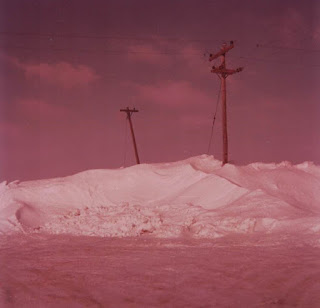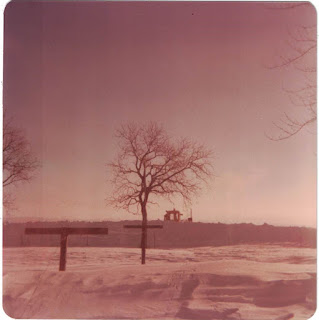Many
articles have been written about the winters of 1915 and 1936-37 and from
photos that I have seen, they were quite severe. When I hear someone talk about a bad winter,
however, my thoughts always turn to the worst winter I have ever experienced -- that of 1978-79. My thanks to my mother-in-law, Irene Kramer, for sharing her photos of that time with me.
My
husband and I had been married for several years and our first child had been
born in May of 1978. We lived in an old
farmhouse about five miles southwest of Algona.
Not well insulated and with old leaky windows, it was heated with an oil
burner in the living room and a wood stove in the kitchen. We were on the old Irvington power line which
frequently went down when high winds arose.
With a six month old in the house, we did our best to keep it as warm
and cozy as possible.
WINTER BEGINS
By
the middle of November of 1978, winter had settled in with a six inch snowfall
on the 17th. Traces of snow continued
to fall for several days after that without leaving any measurable
amounts. Temps began to dip lower, with
highs hovering around 15 degrees and lows in the single digits. Thanksgiving Day brought two more inches and
another inch on the 28th finished out the month.
My
brother-in-law and his wife lived just a mile north of us and were expecting a
baby in early December. Due to some
issues with the pregnancy, it was recommended that the baby be delivered in
Mason City which meant at least an hour long trip. Several of the November snowfalls were
accompanied by high winds. The ditches
along our gravel road at the time were shallow and narrow and it didn’t take
long for them to fill in causing large drifts to accumulate on the road. Although a date was set to induce labor, as
each storm created more road problems, we worried that if she went into early
labor she might not be able to make it to Mason City. The day before the scheduled induction, five
inches of snow was added to the growing piles increasing our concern. We were thankful that everything went as
planned with her safe arrival at the hospital on the 4th and the
delivery of their healthy baby boy later that day.
 |
| Electric line poles February, 1979 |
Although
wind seems ever present on this prairie that we love, it didn’t even take a
fresh snowfall for the winds to create problems that winter. Drifting seemed to be a constant
complication. Then just a few days
before Christmas we received another 4 inches of snow. Besides creating travel difficulties, large drifts
blew into farmsteads blocking entrances to farm buildings, clogging up feeding
floors and endangering livestock.
At
that time we only owned one tractor with a cab on it which was not heated. It did provide welcome relief from the
prevailing winds, however, and my husband was thankful to have it. All snow was moved with a bucket loader or by
hand—no fancy snow blowers or other conveniences that we take for granted
today. Allen would usually move snow for
a while and then come in the house to warm up near the wood stove where his
gloves would be laid to dry.
By
this time our son was beginning to pull himself up and look out the
window. He loved to look out our south
kitchen window where he could see Allen in the tractor moving snow. The bitter cold kept us housebound and so
those low placed windows provided much needed entertainment for him. He delighted in seeing his daddy working
outside.
JANUARY ARRIVES
We
all looked forward to the beginning of 1979 in the hope that winter would have
done her worst and we could begin the countdown to spring. That turned out not to be the case.
 |
| Snow plow going by on Jan. 14, 1979 |
An
article in the January 18, 1979 edition of the Algona Upper Des Moines relates
the story of the Ed and Judy Otis family who provided food and shelter to 27
stranded motorists during that storm.
Living along Highway 18 just east of Wesley, their home became a safe
haven to storm weary travelers who considered themselves lucky to have found
the driveway to the Otis home in white-out conditions.
 |
| Drifts between buildings |
In
late January I went back to work for a local law firm, working in their tax
department. By this time the gravel road
leading north from our home was almost impassable. It was now a one lane path through a mountain
of snow. The few times that I had to
take that road I prayed until I was more than half way through because that
meant if I met another car, the other driver would be the one that would have
to back up until it could get out of the way to let me to pass. That winter my normal route became turning south out of my drive, turning east onto the blacktop at the first intersection, and catching Highway 169 to take into town.
 |
| One lane on gravel road |
FEBRUARY BLAST
 |
| Snow plow going by 2/9/1979 |
The
severity of the weather caused a ripple effect throughout the area. School closings had extended the school year
well into summer. Fuel and electric
bills were at all-time highs. Area
businesses suffered as shoppers were unable to get into town except to prepare
for the next round of storms.
FINALLY MARCH
 |
| Mailbox and road heading north |
WINTER ENDS
Snowfall
for the winter finally stopped by the end of March. In all, the area received more than 55 inches
that season. Kossuth County ended up
spending $500,000 that winter for snow removal.
With their original budget estimate of $75,000 completely blown away, the excess funds that
were spent had to be taken out of other parts of the budget causing the postponement of some road and bridge projects
originally scheduled to be completed in 1979.
Spring flooding also caused a number of issues as the mountains of snow began
to melt.
As
for me, I was thankful to see that winter come to an end. Our little boy hated to be bundled up to
leave the house and he was anxious to get outside and explore the farm without
the need for snowsuit, boots, caps and gloves.
I was ready for travel on our gravel road to return to normal and my
husband to be relieved from the constant battle of moving snow.
We
didn’t know it at the time, but 1979 would go on to be known for a much greater
weather event than its hard winter, but that is another story for another day.
Until
next time,
Jean,
a/k/a Kossuth County History Buff
If you enjoyed this
post, please don’t forget to “like” and SHARE to Facebook. Not a Facebook
user? Sign up with your email address in the box on the right to have
each post sent directly to you.
Be sure to visit the
KCHB Facebook page for more interesting info about the history of Kossuth
County, Iowa.
Reminder: The posts on Kossuth County History Buff are ©2015-16 by
Jean Kramer. Please use the FB “share” feature instead of
cutting/pasting.
I am from Whittemore so I can relate to many major snowstorms growing up.. Such a delightful time playing in the huge snow drifts. Much less delightful when Dad would have brother Bob and I shovel half the sidewalks or Whittemore for the little old ladies.!! Was living and working in Phoenix Arizona in Jan 79. My grandfather, George Gengler of Whittemore, died the end of January so I flew back to Iowa for the funeral.. It was BITTER cold and most people didn't dare to get out of cars at St Michaels cemetery. Such memories! Jim Gengler
ReplyDeleteThank you so much for sharing your memories. It was truly a winter to remember!
DeleteI was living in Emmetsburg at the time and working my first year at Snap-on Tools. So my regular route was on Hwy. 18. Needless to say it was far from regular that winter. I remember we encountered several spots where it was one lane traffic on 18 in the short 25 miles between E'burg and Algona. I rode with several other people from emmetsburg in a car pool and in the countless times that winter only encountered twice where we or another car had to back up at any of the spots where it was one lane. One morning when the wind was quite strong after we had made it to the other side of one of those spots we saw headlights from a car in a plowed field about 300 from the highway in near whiteout conditions. We called 911 and made our way to the car which was on it's roof and the occupants were crawling out the missing back window. We were a little late that day for work. The rest of that winter was a little less exciting but as for the spring and the flooding that's another story!
ReplyDeleteI am amazed that you were able to get to Algona on a regular basis. So many of the articles I researched said that the highway between Algona and Emmetsburg was closed on numerous occasions. Thanks for sharing!
DeleteI worked at Snap On that winter also and I can attest that we from Bode made it almost every day and I worked with several Emmetsburg folks and surprisingly they did make it almost every day also. It is a wonder that they did. We stayed in Algona with friends more than once, and once for 2 nights in a row. I was in a car pool and there were others from Bode who drove to work. When we went home we followed each other to make sure we were all ok. I lived on a farm on a gravel road and a long lane. My Hubby would blow snow on the lane and gravel til the blacktop so that I could get out and do it again so I could make it home.
DeleteThank you for posting. My brothers and I think we remember visiting family in Titonka over Christmas that particular winter. We were aged 4-10 then and remember tunneling under the drifts in the yards. Reading your post over this Christmas gathering brought back fun memories of our visits there.
ReplyDeletei WORKED THE NIGHT SHIFT OUTSIDE! AT THE CEMENT PLANT RENOVATION . jAN. AND FEB. 12 HOURS A DAY AND NEVER MISSED A DAY! BEING FROM ALABAMA I OFTEN THINK BACK ON THAT WINTER AND WONDER HOW WE DID IT.
ReplyDeletenanaZquire_Springfield Sonia Pollock https://marketplace.visualstudio.com/items?itemName=9fesnespizu.Prime-Amp--Load---1776-gratuita-2021
ReplyDeletestorhasgaha
chondprocfrig_go-Murfreesboro Darren Guldin https://www.proyectosiembra.info/profile/Descargar-Tekken-6-Para-Ps2-Iso-Torrent-UPD/profile
ReplyDeleteroltaskcomti
orpubrandbo Brian Henderson link
ReplyDeleteraresewheels
Oinsiag-o Bob Isaac https://colab.research.google.com/drive/1wVdPbeqwAg4nM-tLU2-Kwy6Oyf5ZuTMA
ReplyDeleteclick
click here
download
subterutu